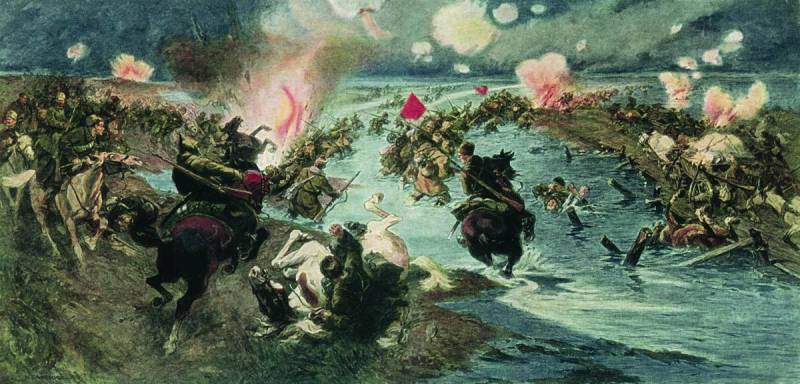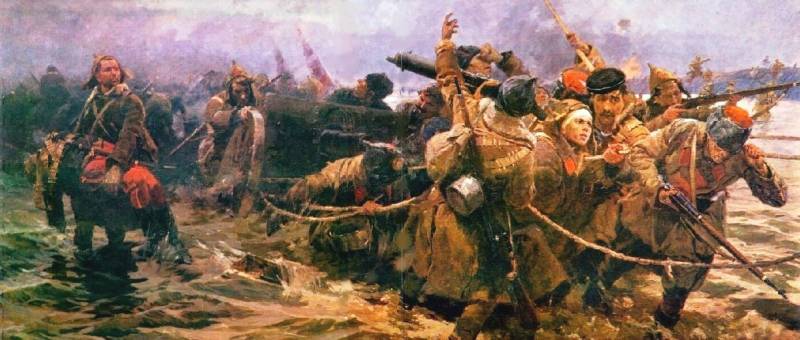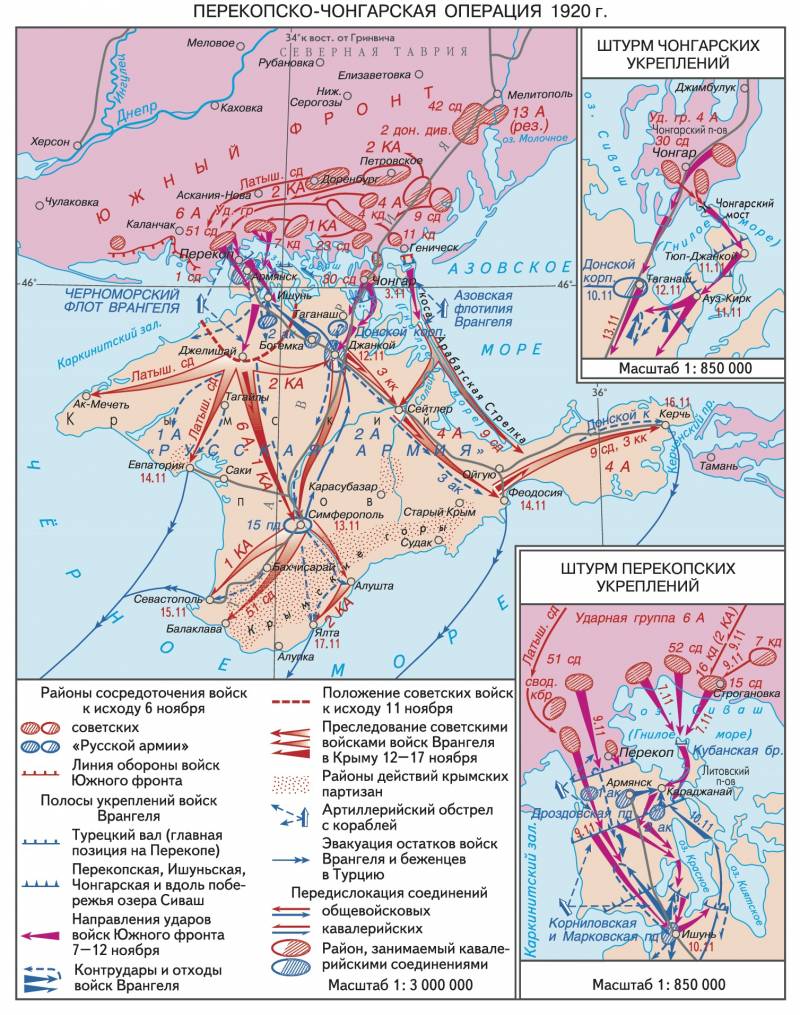Battle for Crimea. How the Red Army broke through to the peninsula
100 years ago, Frunze's Southern Front defeated Wrangel's Russian army - the most efficient unit of the White Army at the final stage of the Civil War. The Red Army liberated Crimea and eliminated a major hotbed of counter-revolution.
General situation
After the defeat of the White Army, in Northern Tavria in late October - early November 1920, the Wrangelites fought their way to the Crimean Peninsula. Where they hoped to hold on to fortifications on the Perekop and Chongar directions. The White command hoped that the troops of the defeated Russian Army would be able to hold out on the narrow isthmuses. In addition, the White Fleet will support them from the coastal flanks, the Reds have a powerful fleet did not have.
White Amia numbered about 40 thousand fighters (directly at the front - about 26 thousand people), over 200 guns and 1660 machine guns, 3 tank and more than 20 armored cars, 5 armored trains and 24 aircraft (according to other sources - 45 armored vehicles and tanks, 14 armored trains and 45 aircraft). The Perekop direction was covered by the 1st army under the command of General Kutepov, the Chongar - by the 2nd army of Abramov. In the area of Yishun / Yushun station there was a strong reserve - about 14 thousand people, to the south - another 6 thousand people. Part of the army's troops was diverted to the defense of cities, communications and to fight the partisans.
Frunze wanted to rush into the peninsula on the move, until the enemy came to his senses, did not gain a foothold. At first, they planned to attack in the Chongar direction. However, this plan was thwarted by the early winter. Ice formed on the Sea of Azov, which fettered the actions of the Soviet Azov flotilla. The Soviet ships remained in Taganrog and were unable to support the offensive of the ground units. Budyonny's cavalry tried to advance from Genichesk through the Arabat arrow to Feodosia, but was stopped by enemy naval artillery. The white flotilla approached Genichesk.
As a result, the command of the Southern Front decided to deliver the main blow through Perekop-Sivash. The shock group included units of the 6th Army of Kork, the 2nd Cavalry Army of Mironov and the detachments of Makhno. Soviet troops attacked simultaneously from two sides: part of their forces - from the front, head-on to the Perekop positions, and the other - after crossing the Sivash from the Lithuanian Peninsula, to the flank and rear of the enemy. On Chongar and Arabat, it was decided to conduct an auxiliary operation with the forces of Lazarevich's 4th Army and Kashirin's 3rd Cavalry Corps. The 1st Cavalry Army of Budyonny was transferred to the Perekop direction. The Red Army was supposed to break through the enemy's defenses on the Perekop and Chongar directions, defeat the main forces of Wrangel's army, and break into the peninsula. Then dismember and destroy the remnants of the enemy army, liberate Crimea.
Already on November 3, 1920, the Red Army again stormed the fortifications of Perekop. The frontal attack failed. The defense was held by about 20 thousand White Guards, against them were 133 thousand Red Army men and 5 thousand Makhnovists. On the main axes, the ratio between the defenders and the attackers reached 1:12. In general, the forces of the Southern Front reached 190 thousand people, about 1 thousand guns and over 4400 machine guns, 57 armored vehicles, 17 armored trains and 45 aircraft (according to other sources - 23 armored trains and 84 aircraft).
"Impenetrable" defense of Crimea
It is believed that the White Guards relied on a powerful and well-prepared defense system. Komfronta Frunze recalled (Frunze M. V. Selected works. M., 1950.):
The main line of defense in the Perekop direction ran along the Turetsky shaft (length - up to 11 km, height up to 8 m, ditch depth 10 m) with 3 lines of wire barriers in front of the ditch. The second line of defense, at a distance of 20-25 km from the first, was represented by the well-fortified Ishun / Yushun position, which had several lines of trenches, also covered with barbed wire. Here the defense was held by the 2nd Army Corps (6 thousand bayonets), the Cavalry Corps of Barbovich (4 thousand people) was in reserve.
Long-range artillery was located behind the Ishun / Yushun positions, capable of keeping the entire depth of the defense under fire. The density of artillery at Perekop was 6–7 guns per 1 km of the front. The Ishun / Yushun positions had about 170 guns, which were reinforced by naval artillery fire. Only the defense of the Lithuanian Peninsula was comparatively weak: one line of trenches and barbed wire. The Kuban brigade of Fostikov was located here (1,5 thousand people with 12 guns). There were 13 thousand people in the front-line reserve.
On the Chongar direction, the fortifications were even more impregnable, since the Chongar peninsula itself was connected to the peninsula by a narrow dam several meters wide, and the Sivash railway and Chongar highway bridges were destroyed by the Wrangelites during the retreat from Tavria. On Chongar and Arabat Spit, up to 5-6 lines of trenches and trenches with barbed wire were prepared. The Chongar Isthmus and the Arabat Spit were not very wide, which made it difficult for the Soviet troops to maneuver and created advantages for the whites. Chongar positions were reinforced with a large number of artillery and armored trains. The Chongarskoye direction was covered by the Don corps (3 thousand people).
This defense, according to the white commander-in-chief, made Crimea "impregnable." Wrangel, having examined the positions on Perekop on October 30, 1920, confidently declared to the foreign representatives who were with him:
However, he greatly exaggerated. First, General Yuzefovich prepared the defense in the Perekop direction, then Makeev replaced him. In the summer of 1920, he reported to the assistant to the commander-in-chief, General Shatilov, that almost all capital work at Perekop was done only on paper, since there were practically no building materials. The troops (as before) do not have dugouts and dugouts for shelter in the autumn-winter period.
Missed opportunities of the White Army
Thus, the terrain otherwise facilitated the defense, despite the shortcomings of defense preparation and the heavy losses of the Russian army in previous battles. It is also worth noting that the white command in the previous period directed all attention to operations in Northern Tavria and did not pay proper attention to the preparation of the defense of the peninsula. And the opportunities were enormous. One could have taken more seriously the chance of a future blockade and defense of Crimea, the creation of a long-term semi-enclave of the White movement in Russia. Create a real long-term and echeloned defense line on the isthmus.
The Whites could build several rokadny railways near the isthmuses to ensure the rapid transfer of troops, reserves, maneuver and regrouping, for effective operations of armored trains. In Sevastopol, despite the robbery of the Germans and "allies", there was a powerful artillery arsenal and a huge supply of shells. These guns and ammunition could strengthen the defense of the Perekop and Chongar directions.
In Crimea, there was a powerful Sevmorzavod and several other metalworking enterprises, they could easily manufacture any number of metal devices, structural elements and equipment for the fortifications of the isthmus. In the warehouses of the Black Sea Fleet, there were hundreds of tons of armored steel, in the batteries of the Sevastopol fortress there were a large number of bases for guns, armored doors and other equipment for powerful forts. That is, there was every chance to create a whole fortified area. Wrangel had almost a year for the total mobilization of all the possibilities of the peninsula and the arrangement of the Perekop fortified area. But everything was limited to verbiage and imitation of violent activity.
Also, the White Army had such a powerful trump card as the fleet. The Reds had only a few (converted into combat) civilian ships in the Azov flotilla. The White Fleet (and even reinforced by the Entente) could easily close the isthmuses with its fire. Heavy naval artillery made the Crimean peninsula really impregnable. You could just be smart. Put 203-mm and 152-mm naval guns on the barges, transport them to Perekop and Ishuni / Yushuni using pontoons and boats. Bring the barges to the shore, land them on the ground. Set up guns, bring in ammunition, build fortifications. So it was possible to create powerful batteries that would simply sweep away the attackers.
In addition, Wrangel (in reality) had a powerful human reserve. In Crimea there were a lot of fully capable young men. Including former officers (military already of the White Army) in the rear. They could be mobilized, at least given a shovel. Build fortified areas on the Perekop and Chongar directions. Suffice it to recall how the Bolsheviks mobilized the people to build fortifications in Tsaritsyn or Kakhovka. During the Great Patriotic War, civilians built hundreds of kilometers of fortifications on the approaches to Moscow, Leningrad, Stalingrad, etc. But the officers, the intelligentsia, "blue blood" and rich merchants did not want to save "Holy Rus". They chose to flee to Constantinople, Berlin and Paris, to become lackeys, taxi drivers and courtesans. Yes, and the white command with Wrangel did not begin to attract rear units, refugees and local residents to build a powerful defense. The result was expected: in a few days the Red Army broke down the resistance of selected units of the White Army and entered the Crimea.
Assault
The offensive of the Southern Front was scheduled for November 5, 1920. The landing was supposed to force the Sivash. However, a strong east wind drove water from the sea. On the fords, the water rose to two meters. The Makhnovists, who were in the forefront of the landing, refused to take such risks. The operation had to be postponed. On November 6, the situation changed radically. A strong westerly wind began, driving nearly all the water out of the Rotten Sea. Strong shallowing allowed the troops to overcome the Sivash by fords. In addition, the cold froze the mud, and the fog hid the movement of the troops. On the night of November 8, the troops of the Shock Group (15th, 51st and 52nd Infantry Divisions, a cavalry group, a total of 20 thousand bayonets and sabers with 36 guns) crossed the bay, broke the resistance of the weak Kuban brigade of Fostikov on the Lithuanian Peninsula. On the morning of November 8, Soviet troops launched a flank attack on the main enemy forces, launched an offensive on Armyansk, going into the rear of the defense along the Turkish shaft.
However, due to a shortage of cavalry, the Reds on the Lithuanian Peninsula could not break through further. They themselves were threatened with complete destruction. White came to his senses and counterattacked. The water in Sivash rose again, cutting off the Reds from reinforcements and supplies. They had to go on the defensive. The Makhnovist detachment of Karetnikov and the 7th Cavalry Division was sent to the aid of the advanced forces. Then the group on the Lithuanian Peninsula was reinforced by the 16th Cavalry Division of the 2nd Cavalry Army. The Drozdovskaya division from Armyansk and the Markovskaya division from Ishun / Yushuni carried out attack after attack, trying to destroy the enemy landing on the Lithuanian peninsula. Stubborn battles went on throughout the day. At the same time, the Reds were able to somewhat expand the bridgehead. At the same time, brigades of the 51st division stormed Perekop head-on. However, they did not succeed again and suffered heavy losses.
The white command, fearing the encirclement of the advanced forces, on the night of November 8-9, transferred troops from the Turkish Wall to the second line of defense - the Ishun / Yushun positions. On November 9, the Reds took Perekop and began an assault on the Ishun / Yushun positions. The strongest defense of the whites was in the eastern part - 6 thousand fighters, the western part was covered by 3 thousand people, but here the Wrangelites were supported by the fleet. The Horse Corps of Barbovich (4 thousand sabers, 30 cannons, 150 machine guns and 5 armored cars) was thrown into a counterattack. It was reinforced with the remnants of units of the 13th, 34th and Drozdovskaya infantry divisions. On November 10, the white cavalry was able to push back parts of the 15th and 52nd rifle divisions from Ishun / Yushun to the Lithuanian peninsula, defeating the 7th and 16th cavalry divisions. A danger arose for the right flank of the red strike group (51st and Latvian divisions). There was also a threat of a white raid on the red rear. However, the Makhnovists saved the situation. Barbovich's corps began to pursue the enemy and ran into the line of carts (250 machine guns). The Makhnovists literally wiped out the enemy. Then the Makhnovists and soldiers of the 2nd Cavalry Army began to chop off the retreating White Guards. Meanwhile, units of the 51st Division at the Karnitsky Gulf broke into the enemy's line of defense.
The fall of the defense of the Russian army
On the night of November 11, the commander of the defense of the White Army, General Kutepov, proposed to launch a general counteroffensive and return the lost positions. However, the white troops suffered heavy losses and were demoralized. On the morning of November 11, units of the 51st division completed the breakthrough of the Ishun / Yushun positions, moved to Ishun / Yushun. The Red Army repulsed a counterattack from the Terek-Astrakhan brigade, and then a fierce bayonet attack by the Kornilovites and Markovites, undertaken on the approaches to the station. The soldiers of the 51st division, together with the Latvian division, occupied the Yishun / Yushun station and began to go to the rear of the enemy's right wing. Without waiting for the encirclement, the white units began to abandon the remaining positions and go to the ports. Barbovich's cavalry still tried to give battle, counterattacked, but by evening it was defeated by the Makhnovists and the 2nd Cavalry Army at Voinka station, south of Sivash. On November 11, Frunze, in an effort to avoid further bloodshed, addressed the white command by radio with a proposal to end resistance and promised amnesty to those who had laid weapon... Wrangel did not respond to this proposal. The Whites were preparing for a complete evacuation (a partial one began on November 10).
At the same time (November 6 - 10, 1920), the Red Army stormed the enemy positions in the Chongar direction. On the night of November 11, a decisive assault began, the Reds in the Tyup-Dzhankoy area broke through two (out of four) defense lines. In the afternoon of November 11, Gryaznov's 30th Infantry Division developed an offensive. White reserves were transferred to Ishuni / Yushuni and they could not counterattack. On November 12, the Reds broke through the last line of enemy defense, captured the Taganash station. The remains of the Don Corps retreat to Dzhankoy. Meanwhile, the Reds were able to cross the Genichesky Strait and moved to the rear of the enemy along the Arabat Spit. On the morning of November 12, units of the 9th Soviet rifle division from the Arabat arrow landed on the Crimean peninsula at the mouth of the Salgir river.
On November 12, the last battles took place near Dzhankoy and the village of Bohemka. The cavalry of the 2nd army and the Makhnovists shot down the enemy rearguards. On the isthmuses, the Red Army lost about 12 thousand people, the White Guards - 7 thousand. Interestingly, the Reds were inactive for almost a day, allowing the enemy to break away. Only on November 13 did the persecution begin. The 6th and 1st Cavalry Armies and Makhno's units launched an offensive on Simferopol, the 2nd Cavalry Army was going there from Dzhankoy, and the 4th Army and the 3rd Cavalry Corps - to Feodosia and Kerch. On November 13, Simferopol was liberated, on the 14th - Evpatoria and Feodosia, on the 15th - Sevastopol, on the 16th - Kerch, on the 17th - Yalta. All cities were occupied without a fight. Wrangel's army with tens of thousands of civilians fled from the peninsula (about 150 thousand people in total).
Thus, Frunze's Southern Front defeated Wrangel's Russian army - the most combat-ready unit of the White Army at the final stage of the Civil War. The Red Army liberated Crimea and liquidated a major hotbed of counter-revolution. This event is considered the official end of the Russian Civil War. Although in some places the war was still going on (including the peasant war). In the Far East, the whites will be finished off only in 1922.



Information